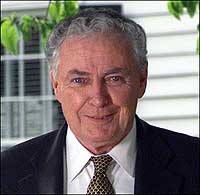Page content
President's Message
Confident in Our Expectation
Spring is a time of renewal at Colonial Williamsburg, a time when our marvelous gardens come into bloom and guests start to crowd the streets once more. As the promise of this time of year unfolds, it is worth pausing to reflect on the twelve months past, and to consider the prospects of seasons to come. Since last spring, despite disappointing attendance figures, much has happened that is good for Colonial Williamsburg, and our prospects are encouraging.
We reduced our deficit by $10 million, or more than 25 percent, in 2003. Cost cutting alone saved $15 million in expenditures.We received more than $12 million in annual fund contributions, a more than 3 percent increase from the year before, and a record. Our total fund-raising yielded nearly $40 million. There were again more than 100,000 donors, and they pushed the Campaign for Colonial Williamsburg past 72 percent of its $500 million goal.
The recovering stock market enhanced the Colonial Williamsburg Foundation's endowment by about 22 percent, increasing its value by $66 million after withdrawals for operating and capital expenses, giving us a more secure financial footing. All encouraging developments.
Still, admissions, which were down 9 percent, and resort revenues did not rise to our expectations, and that is cause for concern. In 2004, we must grow attendance, and ticket sales, hospitality, products, and other endeavors, all the while remaining focused on our mission, history education and preservation.
We have developed a more dynamic approach to Historic Area presentations. In the year ahead, guests and interpreters will share afresh the adventures of 1774, a year when the community confronted revolutionary changes in politics, religion, education, and economics.
Throughout the day, guests will encounter "streetscapes"—impromptu interactions between 1770s Williamsburg characters going about the business of becoming Americans. There will be audiences with founding fathers, spirited discussions and heated debates about England and independence, and revealing interpretations of slavery.There will be more interactive experiences for youngsters, new family programming, and expanded African American and Native American interpretations.
In 2005 we will improve upon these advances with programs tailored to attendance forecasts and to significant passages in the story of eighteenth-century Williamsburg. Changing themes as we go, we'll move through nine successive periods past such milestones as the Stamp Act Crisis, the refusal to import British goods, and the call for independence, giving guests fresh reason to return as the months and programming advance.
Guests must know about what is new and bright and lively at Colonial Williamsburg if they are to take advantage of it, and, in a competitive travel market, they must be given encouragement and incentive to come. To that end, we're continuing a focused marketing effort, "America. Chapter I." The plan promotes the Historic Area in the context of the Historic Triangle, and communicates a missionbased message in a way that appeals to the modern traveler, makes tailored use of the media, and is agile enough to exploit unexpected opportunities.
Our marketing also promotes business at Colonial Williamsburg's shops, taverns, restaurants, hotels, and golf courses.This year we will open Williamsburg at Home—featuring furnishings and related products—in a splendid new building on Merchants Square. We will lease space there to a women's fashion store, and provide offices for a leading investment firm.We will also welcome the opening of another fine restaurant a few steps away. We'll start the transformation of the Williamsburg Lodge, the engine that drives our hospitality enterprise. Also in our plans are expanded spa and fitness facilities, as well as a health evaluation center, providing new opportunities for our guests and keeping us competitive with other destinations.
Ours is an energetic stewardship. These new ventures, our new plans, indeed, everything we do to attain financial equilibrium, nourish our educational endeavors. This spring we renew our dedication to the perpetuation of this remarkable place, confident in our expectation that at Colonial Williamsburg, forever, the future may learn from the past.
Colin G. Campbell

